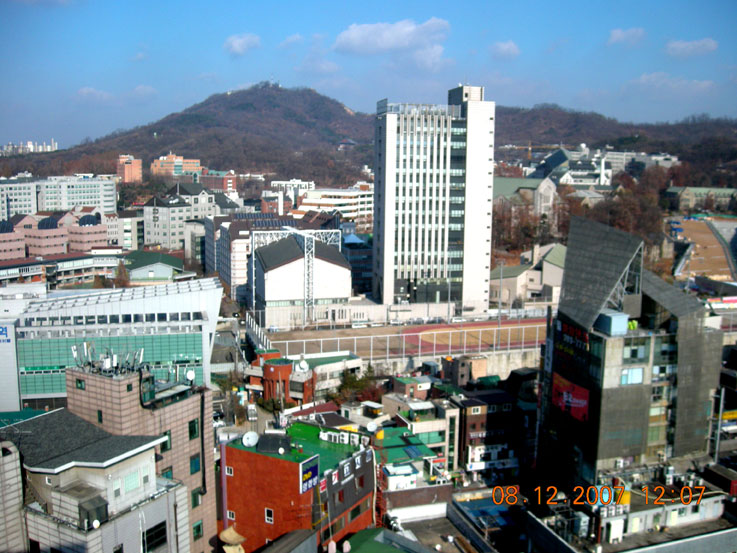it's been a while since i've posted a field trip, so here's another sightseeing option smack dab in the middle of seodaemun-gu for the nature lover in you. just behind ewha and yonsei universities is a big hill and a buddhist temple to boot!
just behind ewha and yonsei universities is a big hill and a buddhist temple to boot!
before heading home for the past several weeks, i found myself grumbling about my neighborhood's sheer density. located between the shinchon and edae subway stations (line #2), it's one of seoul's busier areas, which means noise, gobs of people and pollution. that said, it's been a good starting point for wandering the city. what follows is one very accessible site worth visiting.
ansan + bongwonsa (봉원사) buddhist temple
70 percent of korea is mountains, making it one of the world's most topographically interesting places. universities in seoul are often located at the base of some of these small peaks. just blocks north of my home are yonsei and ewha women's universities, and whaddya know, ansan (aka muaksan) rises just behind them. the edae neighborhood with ansan in the background.
the edae neighborhood with ansan in the background.
i think i've mentioned before that the hills are one of seoul's saving graces. in addition to making the local landscape interesting, they also tend to be one of the megapolis' few greenspaces. ansan is a decent-sized piece of earth, and i feel lucky to have it close at hand when the concrete gets overwhelming.
shortly after moving here i saw a buddhist temple about 1/3 of the way up the "mountain" and wondered if there might be trails all the way up. koreans are hiking maniacs and since it's the area's most conspicuous peak, it seemed likely. thanks to google earth's aerial vantage point, i could spy what appeared to be paths to the summit. 15th century homeland security.
15th century homeland security.
if you walk behind ewha's campus and keep moving towards higher ground, you'll reach some hiking paths. after a nice 30 minute hike along well-worn dirt trails, i reached ansan's 296-meter peak. there i found seoul monument no. 13, a smoke signal station site presumed to have been built in 1442. these beacons used fire and smoke to warn citizens of emergencies on the joseon kingdom's borders. a precursor to america's goofy homeland security color alert system, one to five signals were lit to communicate the threat level. one signal was lit in peacetime. two when the enemy was spotted. three if it approached, four if they had crossed into joseon land and five when battles were raging. the ansan station is the 2nd to last in an impressive line of signal towers that stretched from almost the chinese border to namsan, currently the site of n seoul tower. the very nice view from ansan (click for larger).
the very nice view from ansan (click for larger).
after enjoying an impressive view of the big city below, on my way down i happened upon badminton courts, small soccer fields and exercise equipment. at one point, there was an outdoor gym with several ajussi working out. it was strange. farther along, however, i found bongwonsa, a buddhist temple founded in 889. in 1748 the complex was moved to its current location from a kilometer or so away. much of the complex was destroyed during the korean war, and, as is often the case, the current buildings date only from 1991-93. sigh. bongwonsa temple and gardens.
bongwonsa temple and gardens.
today, about 50 monks are in residence. i saw about 20 skinny teenage boys exercising at the compound but felt too goofy to photograph them. the temple, which belongs to the t'aego order of korean buddhism champions several educational programs, including regular visits to prisons, orphanages, senior citizen and military facilities.
getting there:→ take subway line 2 to shinchon station (exit #3) and take the bongwon village bus (15 mins)... or just do as i did and walk behind the ewha campus and keep going up!
→ or, take subway line 3 to dongnimmun station (exit #4) and take the bongwon village bus (5 mins).
→ after visiting bongwonsa, poke around for one of the many trails that will eventually lead you to the top.
23 January 2008
field trip #7: ansan
posted by:
matt
at
17:50
![]()
topics: city life, field trip
Subscribe to:
Post Comments (Atom)
Archive
Labels
- city life (129)
- cityplan (8)
- expats (21)
- family (33)
- field trip (25)
- food (18)
- friends (61)
- history (3)
- holidays (27)
- home (30)
- homo (67)
- konglish (13)
- maps (5)
- me (85)
- miscellany (54)
- neighbors (22)
- north korea (5)
- ocd (35)
- plants (9)
- race (15)
- snapshot (23)
- the king (1)
- travel (48)
- usa (45)
- wacky (50)
- work (44)
- 한류 (korean cultural wave) (4)








No comments:
Post a Comment